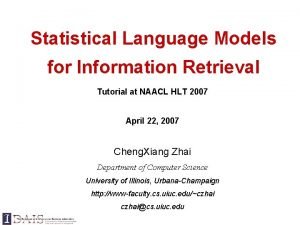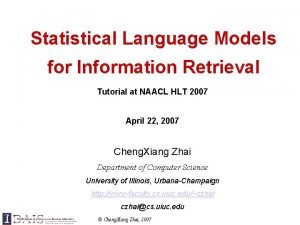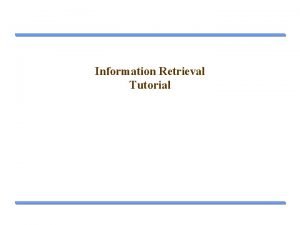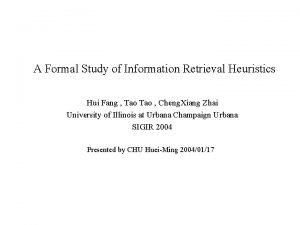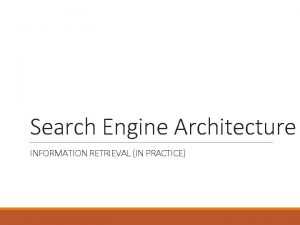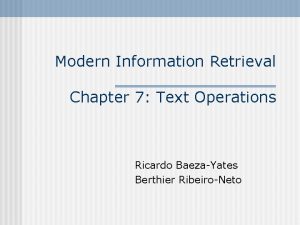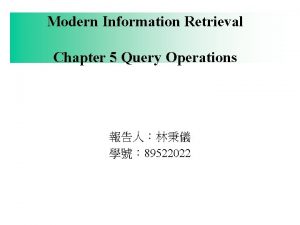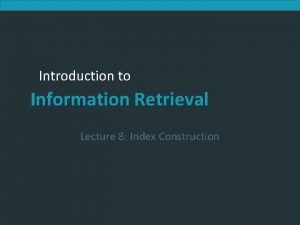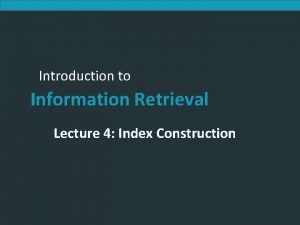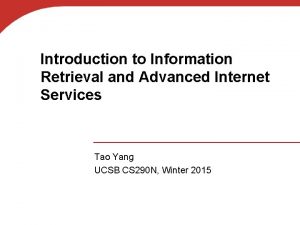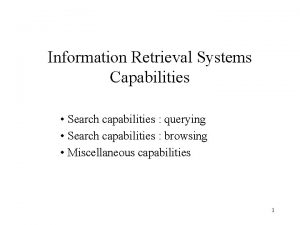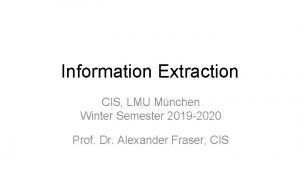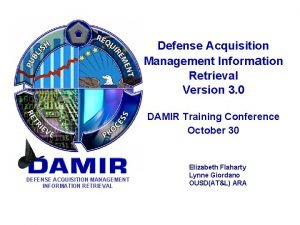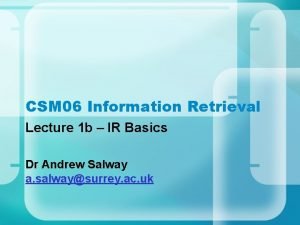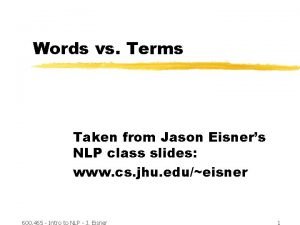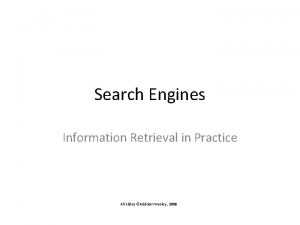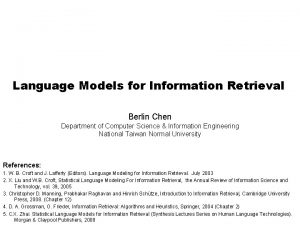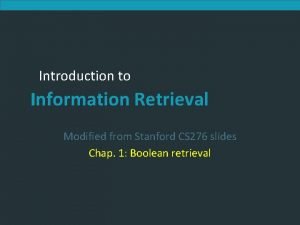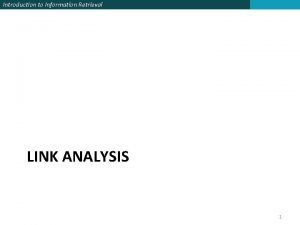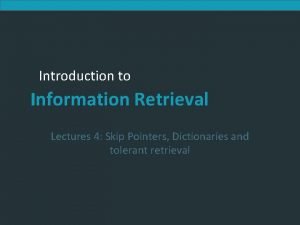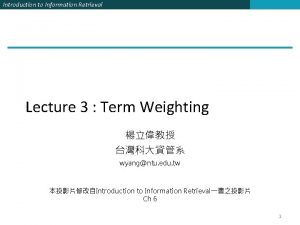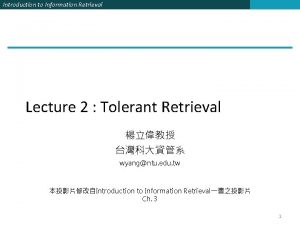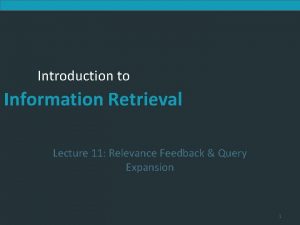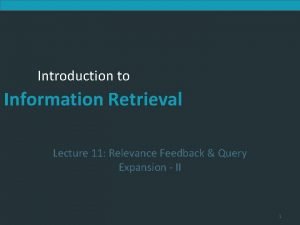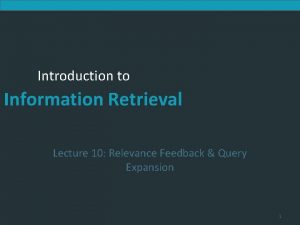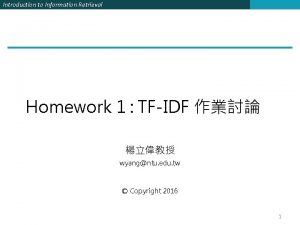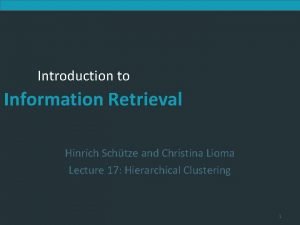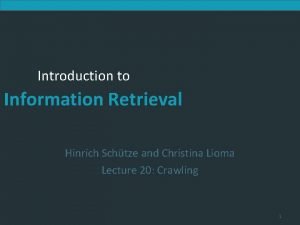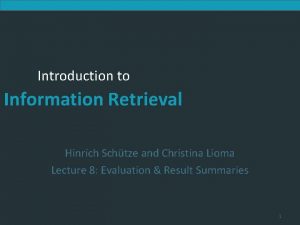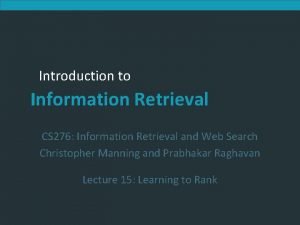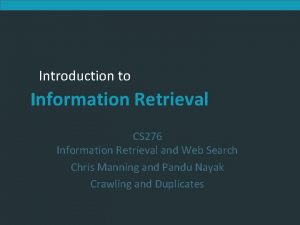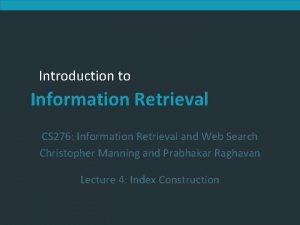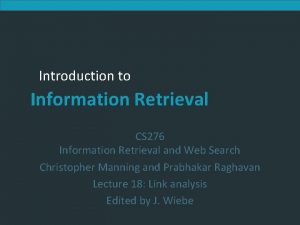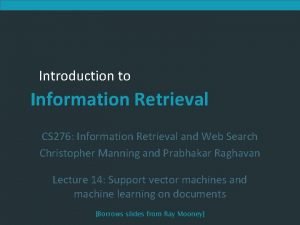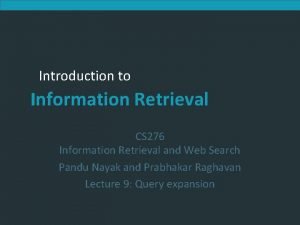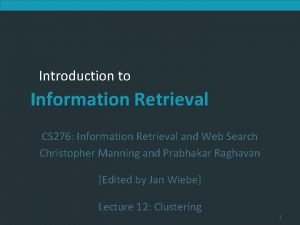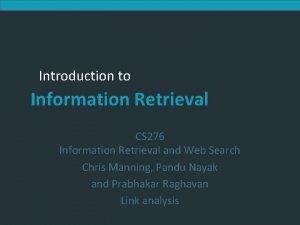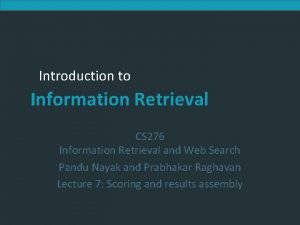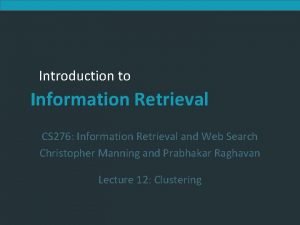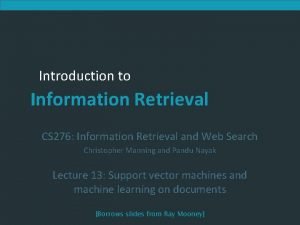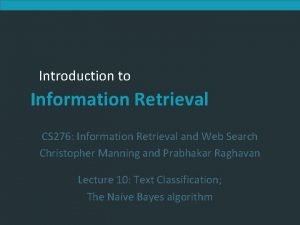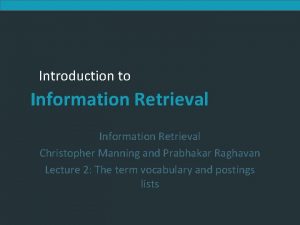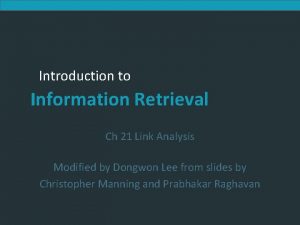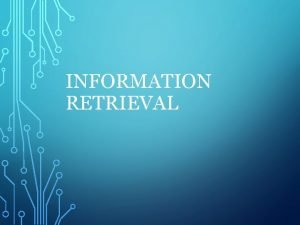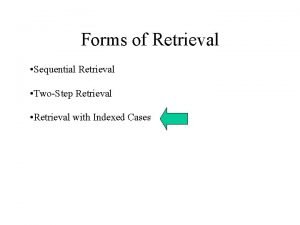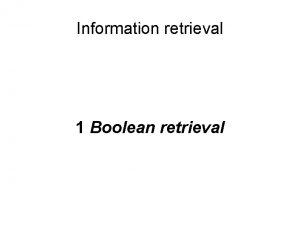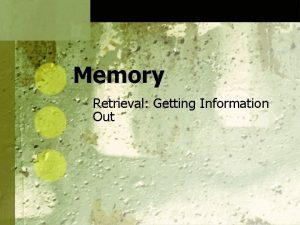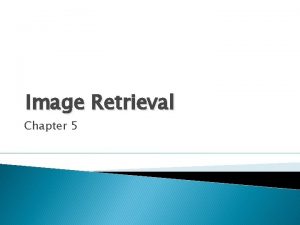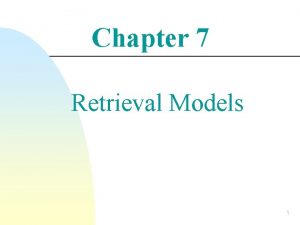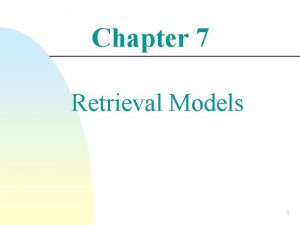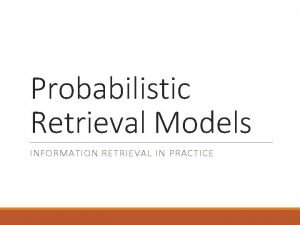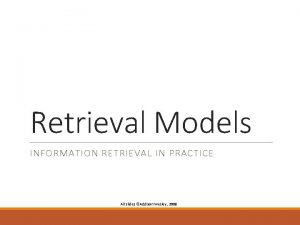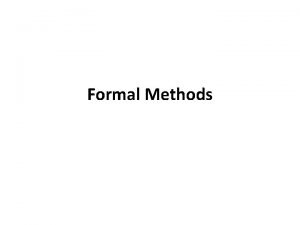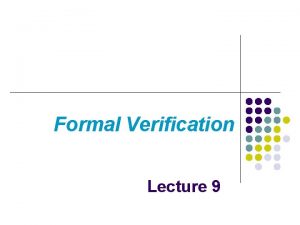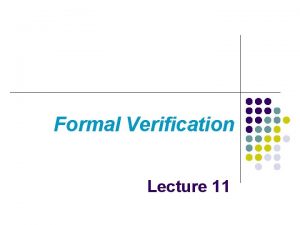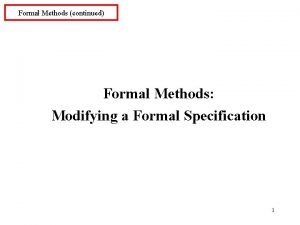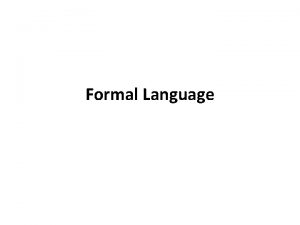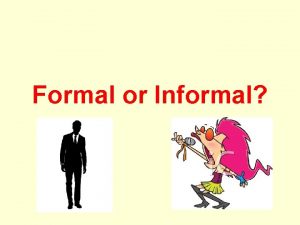A tutorial to formal models of information retrieval
















































- Slides: 48

A tutorial to formal models of information retrieval SIKS basic course on Information Retrieval, 23 May 2007 Djoerd Hiemstra University of Twente hiemstra@cs. utwente. nl http: //www. cs. utwente. nl/~hiemstra

Goal n Gain basic knowledge of IR n n n Intuitive understanding of difficulty of the problem Insight in consequences of modelling assumptions biased comparison of formal models 2

Overview n PART 1: IR modelling n n n Basic technology An overview of formal models PART 2: The Quiz 3

Course material n In your reader: Djoerd Hiemstra, “Information Retrieval Modelling Tutorial”, 2006 please cite: n Djoerd Hiemstra, "Information Retrieval Modelling", In: "Using Language Models for Information Retrieval", Ph. D. Thesis, University of Twente, 2001 n 4

PART-1: Information Retrieval modelling

Information Retrieval documents representation query indexed documents off-line computation on-line computation information problem comparison feedback retrieved documents 6

Full text information retrieval n n n Index based on uncontrolled (free) terms (as opposed to controlled terms) Every word in a document is a potential index term Terms may be linked to specific XML elements in a text (title, abstract, preface, image caption, etc. ) 7

Full text information retrieval n Different views on documents n n External: data not necessarily contained in the document (metadata) Logical: e. g. chapters, sections, abstract Layout: e. g. two columns, A 4 paper, Times Content: the text this is what IR models are about mostly… 8

Full text information retrieval n Automatic processing of natural language: n n n n statistics (counting words) stop list morphological stemming this is what IR part-of-speech tagging models are about compound splitting mostly… partial parsing: noun phrase extraction other: use of thesaurus, named entity recognition, . . . 9

Full text information retrieval n stop list n n stemmer n n n rewrite rules, rules of the thumb sky skies skiing ski compound words n n remove frequent words (the, and, for, etc. ) word contains more than one morpheme Fietsbandventiel fiets, band, ventiel What about “bruidsluier”? phrases n separate words not good predictors: New York 10

Being an IR model apply begin big billi bodi boston brought creat decid docum dump electron employe format good govern hope industri join king live lot massachusett microsoft offic open parti peopl problem recognit revolut sauc save softwar standard state tea thumb worri Massachusetts dumps Microsoft Office Massachusetts The people who brought you the Boston tea party, have joined in another revolution against good King Billy’s Office software. The state government has decided that all electronic documents saved and created by state employees have to use open formats from the beginning of 2007. Microsoft is clearly worried. A lot of people live in Massachusetts and that is a big thumbs up for open sauce. However, it is hoping to get around the problem by applying recognition from an industry standards body for recognition of its own formats as open standards. 11

Being an IR model bitterli central clear cloudier coast cold dai easterli edg flurri forecast frost lead moder northeast part period persist plenti risk shower sleet snow southern southwestern sunshin todai weather wind wintri Today's weather forecast Clear periods leading to a moderate frost in many parts away from the east coast. The northeast will be cloudier, as will the far south, here the risk of a few snow flurries. The bitterly cold easterly wind persisting. Plenty of sunshine around, but rather cloudy in northeast, here some wintry showers. The south also rather cloudy, perhaps sleet or snow edging into southwestern and central southern parts later in day. 12

Full text information retrieval n Advantages: n n n fully automatic indexing (saves time and money) less standardisation (tailored to variation in information need of different users) can still be combined (? ) with aspects of controlled approach (thesaurus, metadata) 13

Full text information retrieval n Main disadvantage: the (professional) user looses his/her control over the system. . . n n because of 'ranking' instead of 'exact matching', the user does not understand why the system does what it does assumptions of stop lists, stemmers, etc. do not hold universally: e. g. the query “last will”: are “last” or “will” stop words? should it retrieve “last would”? 14

15

16

17

Models of information retrieval n A model: n n n abstracts away from the real world uses a branch of mathematics possibly: uses a metaphor for searching 18

Short history of IR modelling n n n Boolean model Document similarity Vector space model Probabilistic retrieval Language models Google Page. Rank (± 1950) (± 1957) (± 1970) (± 1976) (± 1998) 19

The Boolean model (± 1950) n Exact matching: data retrieval (instead of information retrieval) n n n A term specifies a set of documents Boolean logic to combine terms / document sets AND, OR and NOT: intersection, union, and difference 20

The Boolean model (± 1950) n Venn diagrams 21

Statistical similarity between documents (± 1957) n The principle of similarity "The more two representations agree in given elements and their distribution, the higher would be the probability of their representing similar information" (Luhn 1957) 22

Statistical similarity between documents (± 1957) n Vector product n n If the vector has binary components, then the product measures the number of shared terms Vector components might be "weights" 23

Intermezzo: Term weights? ? n tf. idf term weighting schemes n n n a family of hundreds (thousands) of algorithms to assign weights that reflect the importance of a term in a document tf = term frequency: the number of times a term occurs in a document idf = inverse document frequency: usually the logarithm of N/df , where df = document frequency: the number of documents that contains the term, and N is the number of documents 24

Vector space model (± 1970) n n Documents and queries are vectors in a highdimensional space Geometric measures (distances, angles) 25

Vector space model (± 1970) n Cosine of an angle: n n close to 1 if angle is small 0 if vectors are orthogonal 26

Vector space model (± 1970) n n Measuring the angle is like normalising the vectors to length 1. Relevance feedback: move query on the sphere at length 1. (Rocchio 1971) 27

Vector space model (± 1970) n n PRO: Nice metaphor, easily explained; Mathematically sound: geometry; Great for relevance feedback CON: Need term weighting (tf. idf); Hard to model structured queries (Salton & Mc. Gill 1983) 28

Probability ranking (± 1976) n The probability ranking principle "If a reference retrieval system's response to each request is a ranking of the documents in the collections in order of decreasing probability of usefulness to the user (. . . ) then the overall effectiveness will be the best that is obtainable on the basis of the data. (Robertson 1977) 29

Probabilistic retrieval (± 1976) n Probability of getting (retrieving) a relevant document from the set of documents indexed by "social". (Robertson & Sparck-Jones 1976) r = 1 (number of relevant docs containing "social") R = 11 (number of relevant docs) n = 1000 (number of docs containing "social") N = 10000 (total number of docs) 30

Probabilistic retrieval (± 1976) n n Bayes' rule Conditional independence 31

Probabilistic retrieval (± 1976) n n PRO: does not need term weighting CON: within document statistics (tf's) do not play a role Need results from relevance feedback 32

Language models (± 1998) n n n Let's assume we point blindly, one at a time, at 3 words in a document. What is the probability that I, by accident, pointed at the words “SIKS", “Basic" and “Course"? Compute the probability, and use it to rank the documents. 33

Language models (± 1998) n n Given a query T 1, T 2, …, Tn , rank the documents according to the following probability measure: Linear combination of document model and background model i : 1 i : probability of document model probability of background model P(Ti | D) : document model P(Ti) : background model 34

Language models (± 1998) n n n Probability theory / hidden Markov model theory Successfully applied to speech recognition, and: n optical character recognition, part-of-speech tagging, stochastic grammars, spelling correction, machine translation, etc. 35

Google Page. Rank (± 1998) n n n Suppose a million monkeys browse the www by randomly following links At any time, what percentage of the monkeys do we expect to look at page D? Compute the probability, and use it to rank the documents that contain all query terms 36

Google Page. Rank (± 1998) n n Given a document D, the documents page rank at step n is: where P(D | I) : probability that the monkey reaches page D through page I (= 1 / #outlinks of I ) : probability that the follows a link 1 : probability that the monkey types a url 37

PART-2: The formal IR model Quiz

Question 1 n In the Boolean model: how many different sets of documents can be specified with 3 query terms? a) b) c) d) 8 9 256 unlimited 39

Question 2 n In the vector space model: Given 2 documents D 1 and D 2. Suppose the similarity between D 1 and D 2 is 0. 08, what will be the similarity between D 2 and D 1? (i. e. if we interchange the contents of the documents) a) b) c) d) smaller than 0. 08 equal: 0. 08 bigger than 0. 08 it depends on the document's contents 40

Question 3 n In the probabilistic model: suppose we query for twente, and D 1 has more occurrences of twente than D 2, which document will be ranked first? a) D 1 will be ranked before D 2 b) D 2 will be ranked before D 1 c) it depends on the model's implementation d) it depends on the lengths of D 1 and D 2 41

Question 4 n In the language model: let's assume document D consisting of 100 words in total, contains 4 times the word “IR", what is P(T=“IR"|D)? (ignoring the background model) a) b) c) d) smaller than 4/100 = 0. 04 equal to 4/100 = 0. 04 bigger than 4/100 = 0. 04 it depends of the tf. idf weights 42

Question 5 n In the probabilistic model: two documents might get the same score. How many different scores do we expect to get if we enter 3 query terms? a) b) c) d) 8 9 256 unlimited 43

Question 6 n tf. idf weighting: suppose we add some documents to the collection. Do the weights of terms in other document change? a) no b) yes, it affects the tf ' s of other documents c) yes, it affects the idf ' s of other documents d) yes, it affects the tf ' s and the idf ' s of other documents 44

Question 7 n In the vector space model using tf. idf: Suppose we use the cosine similarity (or normalize vectors to unit length). Again we add documents to the collection. Do the weights of terms in other document change? a) b) c) d) no, other documents are unaffected yes, the same weights as in Question 8 yes, all weights in the database change yes, more weights change, but not all 45

Question 8 n In the language model: suppose we use a linear combination of a document model and a collection model. What happens if we take =1 ? a) all docucments get probability > 0 b) documents that contain at least one query term get probability > 0 c) only documents that contain all query terms get probability > 0 d) the system returns a randomly ranked list 46

Conclusion n There is no standard theory for building information retrieval systems n n n unlike e. g. databases: relational model so, not standard query language Still many open issues n n n ranking with structured queries ranking with structured documents combining media: e. g. textual and featurebased queries 47

Conclusion (2) n . . . but there are good models for many problems: n n spam filter? informational queries? navigational queries? relevance feedback? n n Probabilistic Model? Language Model? . Pagerank? . Vector Space? 48
 Statistical language models for information retrieval
Statistical language models for information retrieval Statistical language models for information retrieval
Statistical language models for information retrieval Information retrieval tutorial
Information retrieval tutorial A formal study of information retrieval heuristics
A formal study of information retrieval heuristics Sequential searching in information retrieval
Sequential searching in information retrieval Components of search engine in information retrieval
Components of search engine in information retrieval Recall and precision in information retrieval
Recall and precision in information retrieval Modern information retrieval
Modern information retrieval Query operations in information retrieval
Query operations in information retrieval For skip pointer, more skip leads to
For skip pointer, more skip leads to Index construction in information retrieval
Index construction in information retrieval Bsbi vs spimi
Bsbi vs spimi Which internet service is used for information retrieval
Which internet service is used for information retrieval Wild card queries in information retrieval
Wild card queries in information retrieval Capabilities of information retrieval system
Capabilities of information retrieval system Link analysis in information retrieval
Link analysis in information retrieval Information retrieval lmu
Information retrieval lmu Defense acquisition management information retrieval
Defense acquisition management information retrieval Advantages of information retrieval system
Advantages of information retrieval system Information retrieval nlp
Information retrieval nlp Information retrieval data structures and algorithms
Information retrieval data structures and algorithms Information retrieval slides
Information retrieval slides Relevance information retrieval
Relevance information retrieval Stanford information retrieval
Stanford information retrieval Link analysis in information retrieval
Link analysis in information retrieval Skip pointers in information retrieval
Skip pointers in information retrieval Anthony julius
Anthony julius Levenshtein distance for oslo-snow
Levenshtein distance for oslo-snow Information retrieval
Information retrieval Information retrieval
Information retrieval Relevance information retrieval
Relevance information retrieval Information retrieval
Information retrieval Information retrieval
Information retrieval Information retrieval
Information retrieval Information retrieval
Information retrieval Relevance information retrieval
Relevance information retrieval Cs 276
Cs 276 Cs 276
Cs 276 Information retrieval
Information retrieval Information retrieval
Information retrieval Relevance information retrieval
Relevance information retrieval Information retrieval
Information retrieval Information retrieval
Information retrieval Cs 276
Cs 276 Cs 276
Cs 276 Information retrieval
Information retrieval Information retrieval
Information retrieval Tokenization in information retrieval
Tokenization in information retrieval Link analysis in information retrieval
Link analysis in information retrieval
